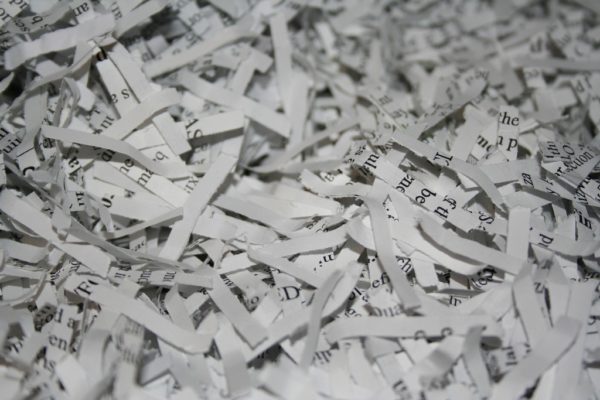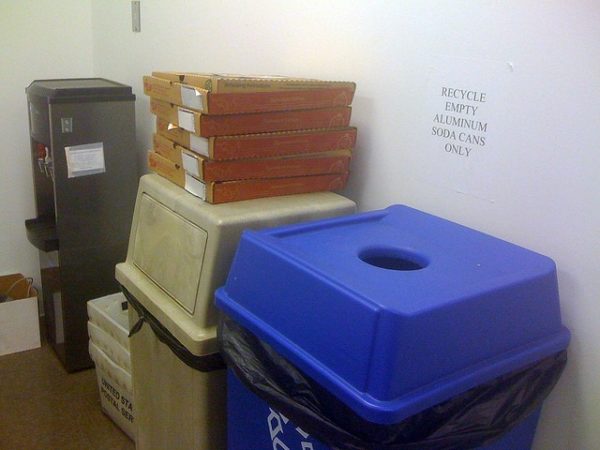Ever wondered if that greasy paper plate could go in your recycling bin? Or would it really be a big deal if you threw in just one plastic bag? It may seem simple to determine what doesn’t go in a recycling bin based on an item’s labels or whether or not it shows a recycling symbol. Unfortunately, it’s not that straightforward.
So, how do you determine which materials you should keep out of your recycling bin? Below, we’ve listed some materials that recycling programs don’t commonly accept and why.
Editor’s note: Curbside recycling programs vary from city to city. This article is intended to be a general guide only. For the most accurate information, please check with your city for a list of materials that are accepted in your bin.

Pizza Boxes and Used Paper Towels and Plates
Many people assume that pizza boxes are recyclable. Most boxes have recycling symbols on them and are traditionally made from corrugated cardboard. They are, in and of themselves, recyclable. However, what makes parts of them non-recyclable is the hot, tasty treat that comes inside — or, more specifically, the grease and cheese from pizza that soil the cardboard.
Pizza boxes that are soiled with food, or any paper product that is stained with grease or food, are not recyclable – unless you remove the tainted portions. Photo: Flickr/Listener42
Food is one of the worst contaminants in the paper recycling process. Grease and oil are not as big of a problem for plastic, metal, and glass, as those materials are recycled using a heat process.
But when paper products are recycled, they are mixed with water and turned into a slurry. Since we all know water and oil don’t mix, the issue is clear. Grease from pizza boxes causes oil to form at the top of the slurry, and paper fibers cannot separate from oils during the pulping process. Essentially, this contaminant causes the entire batch to be ruined. This is the reason that other food-related items are non-recyclable (used paper plates, used napkins, used paper towels, etc.).
Editor’s note: Although a 2020 study demonstrated that used pizza boxes are recyclable even when they have food contamination, most recycling programs are not equipped to handle them. Please confirm with your local recycler that they can process soiled pizza boxes before you put them in your recycling bin.
Read more: The Pizza Box Mystery
Shredded Paper
When you shred paper with a paper shredder, you dramatically decrease the value of the paper because you shorten the length of the paper fiber, which is the source of value of the paper, according to Eric Lombardi, the executive director of Eco-Cycle, one of the largest nonprofit recyclers in the U.S.

Shredded paper has a lower value to recyclers because of its shortened fiber length. Photo: Flickr/Peat Bakke
Nice white computer paper has a long, strong fiber, and every time you recycle that paper, the fiber gets shorter. If done properly, that computer paper can be recycled six to eight times.
However, if you shred that same crisp computer paper, you’re lucky if it can even be recycled once. Commonly, paper mills won’t accept shredded paper because of the difficulties it creates during the sorting process, says Lombardi.
“It gets mixed with everyone’s paper that day, and you put it in a giant pile at the recycling facility, there’s no way somebody is going to put ‘Humpty Dumpty’ back together again,” says Lombardi.
If you have a document that is semi-confidential, rip it by hand three or four times, then throw it into the recycling bin. For documents that absolutely require shredding, locate a resource in your area that specifically handles shredded paper for recycling. Some curbside programs may even accept your shredded paper if it is bagged separately.
Read more: How to Recycle Shredded Paper
Brightly Colored Paper
Believe it or not, bright paper can stop a whole batch of paper from being recycled. The idea behind this one is simple, explains Dan Baril, recycling program manager at the University of Colorado at Boulder. “It’s like the red-sock-in-the-white-load syndrome,” he says. If you need to buy colored paper, avoid really rich colors and opt for pastels. Paper mills can usually handle the lighter tones.
Read more: The Best DIY Paper Projects
Juice Boxes and Milk Cartons
This is another good opportunity to check with your municipality for the best recycling options. Some cities accept milk and juice cartons for recycling with the paperboard stream. However, this is not true everywhere.
And while Eco-Cycle will accept milk and juice cartons, even with the plastic drinking spout left in, they do not recycle milk and juice cartons found in non-refrigerated aisles used for packaging products such as soup and soy, rice, or almond milk.
In 2008, a mere 18% of households had access to recycling programs that accepted cartons. As of 2020, 62.1% of U.S. households can recycle cartons through curbside and drop-off programs.
Read more: Recycling Mystery: Milk and Juice Cartons
Paper Coffee Cups
Currently, only a few communities in the U.S. accept paper coffee cups (also called hot cups) for recycling. The thin polyethylene plastic coating on the cups that helps prevent liquid leaking makes it difficult for most processing services to recycle the cups.
With about 58 billion paper cups used each year in the U.S., the best thing you can do is simply reduce your usage. Bring along a reusable mug or ask your barista if they offer mugs for serving if you’re staying in the store to sip your drink.
“At the end of the day, we wouldn’t have a problem with paper hot cups if everyone was going to the coffee shop with their reusable mug,” says Wendell Simonson, marketing director of Eco-Products Inc., a Boulder, Colorado-based company that sells single-use products that can generally be recycled or composted.
If your community offers composting service, look for cups made with plant-based coating, which allows the cups to be composted.
Read more: Enjoy Your Coffee With Less Waste
Plastic Bags and Film
When left to the machines to sort the recyclable materials, “the one that causes the most heartburn is plastic bags,” says Lombardi. Plastic bags wrap themselves around the equipment, and as a result, the whole plant may have to shut down — wasting time, energy, and money. Repairmen often are hired to come in with knives to cut the plastic bags out of the guts of the machinery, Lombardi explains.
But this doesn’t mean you have to toss your bags into the trash. The good news is that most grocery stores throughout the U.S. now offer plastic bag recycling. In 2007, more than 830 million pounds of plastic bags and film were recycled nationwide, up 27% from 2005. Plastic bags can be made into dozens of new and useful products as well.
Read more: How to Recycle Plastic Bags
The Wrong Plastic Resin
Plastics #1 and #2, made from polyethylene terephthalate (PETE) and high-density polyethylene (HDPE), are the most commonly accepted plastics for recycling. However, just because a plastic is made from HDPE and PETE does not mean that it will be accepted by your community’s recycling program. Instead of focusing solely on the plastic recycling codes, pay attention to the specific details provided by your community’s program, such as “narrow-necked bottles” and “rigid plastics.”
Even with a recycling program that accepts plastics #1-7, it’s often the shape of the plastic product that determines whether or not it can be recycled in that specific program. The most important thing to remember is to check your program and make sure you only put the specific items they accept in your recycling bin.
Read more: The Ultimate Plastic Breakdown
Bottle Caps
Polypropylene (PP), or plastic #5, often makes up the plastic caps on bottles. In the past, we were told to remove the cap. Now, this is not always the case, as some plastic recyclers are able to effectively recycle bottles with caps. Recycling collection and processing technology have improved and demand for the recyclable material has increased. Bottles are ground into flake before being vigorously washed in the recycling process. If the recycler is set up for this, the cap and bottle materials are separated during the cleaning process. The PET bottle sinks while the PP cap material floats.
Not all recyclers have the capacity to process caps, which can jam their machinery. So please confirm with your local program that they accept caps before you put them in your bin.
Broken Glass
Broken glass is recyclable, but it might not be reprocessed into new glass bottles. This is because when glass breaks, it can often be a challenge to separate it by color given the tiny pieces.
This glass can be used as an additive in fiberglass, tile and flooring, pavement, or even turned back into sand to stop beach depletion. However, just because glass is crushed during recycling doesn’t mean you should do this prior to putting it in your bin. This could injure waste haulers or people sorting material at the recycling facility. For this reason, your local program might not accept broken glass in your curbside bin. Please confirm that your program accepts broken glass before you put it in the bin.
Read more: Do’s and Don’ts of Glass Recycling
What Causes Contamination
Knowing what goes in the bin is critical to ensuring the success of the recycling process. Putting the wrong materials into the recycling bin may ruin the entire batch of recyclable materials.
The material in a recycling bin is taken to a material recovery facility (MRF), where the material is separated and processed for selling to companies that buy recycled materials for making products. The higher the quality of the recycled material, the more the companies will want to buy it, and the higher the material’s value is.
However, when you put materials into the recycling bin that shouldn’t be there, you may (at the very least) lower the value of the material or slow down the recycling process. Here’s what can happen when you put the wrong things in the recycling bin:
- Machines that handle the sorting of the materials can become damaged, which means that precious time, energy, and money will be needed to repair the machines.
- If no equipment is available to do the job, more material in the bin that shouldn’t be there makes the job far more difficult and inefficient for workers sorting the material by hand.
- Also, it may inhibit the materials in the bin that should be there from turning into the highest quality materials possible, or it could even send everything in the bin straight to the landfill. It may be cliché, but the expression “one bad apple could spoil the bunch” pretty much sums up the situation.
Editor’s note: This story was updated in September 2020.
The post What NOT to Put in the Bin appeared first on Earth 911.








